
RECOMMENDED READING
On February 18, 2001, Dale Earnhardt hit a wall, and American motorsport was forever changed.
Earnhardt was a legend. His “Garage Mahal” in Mooresville, NC, was a pilgrimage site. Over 17 million watched as his #3 car made light contact with Sterling Marlin, collided with Ken Schrader as he tried to regain control, and smashed into a wall at 160 miles per hour on the final turn of the final lap. His death was a collective trauma.
When the New York Times announced the crash on its front page the next day, though, the headline didn’t refer to him by name. Instead, it called him “Stock Car Star.” Editors did not think it was safe to assume readers would recognize the sport’s most beloved hero.
By 2001, such northern disdain was already out of date. Driving fast in an oval was no provincial pastime; NASCAR had gone national. Its tracks seated more fans than the largest football stadiums. Its ratings surpassed those of Major League Baseball in some regions, and it was poised to surpass the other “Big Four” American sports leagues, the NHL, NBA, and NFL. In fact, NASCAR had just signed an unprecedented $2.4 billion television contract. The 2001 Daytona 500 was the first race to be aired under it.
These modernizing forces accelerated after Earnhardt’s death, and partly because of it. The crash marked the moment when NASCAR undertook a deliberate transformation to make itself more commercially appealing, more scientifically managed, and less distinctively Southern—the opposite of what Earnhardt stood for. We are living with the consequences today.
Recommended Reading
Tracing the Path of the Modern GOP, From Reagan to Trump
The Wall Street Journal’s Gerald Seib and American Compass’s Oren Cass discuss future paths for the GOP.
The Republican Identity Crisis After Trump
Nicholas Lemann discusses the ideological future of both parties, highlighting American Compass as a leader in the movement to bring back a genuinely conservative approach to economics.
What Will The GOP Look Like After Trump?
Donald Trump’s presence in 2016 was heralded as a fundamental shock to the system, as a new way for the Republican Party, as a final nail in the coffin of zombie Reagan-era public policy pushed by the billionaire and think tank class in Washington.












